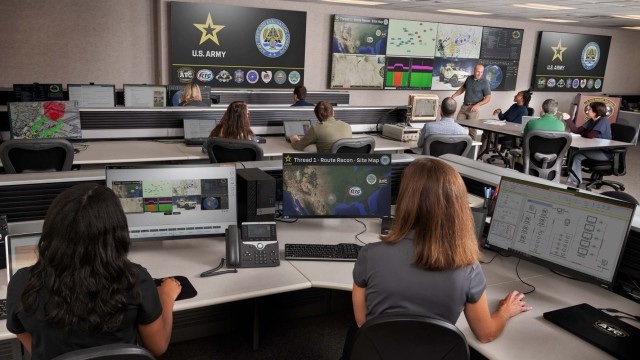
ABERDEEN PROVING GROUND, Md. — The U.S. Army Test and Evaluation Command executed its first Multi-Domain Operations Distributed Live, Virtual, Constructive Initial Operational Capability Demonstration across ATEC’s geographically diverse sites on Oct. 19.
This demonstration was the culmination of an ATEC enterprise modernization project, comprised of eight ATEC subordinate organizations on a distributed network, to establish an MDO scale distributed LVC test environment.
“The key focus of this event was to tie the ATEC subordinate organizations across the country on a distributed test network,” said Dr. Ken LeSueur, lead technical coordinator of the event supporting the U.S. Army Redstone Test Center. “We wanted to exercise a mixture of live, virtual and constructive elements operating on an MDO scale test scenario across that environment, collect data in that environment and push toward real-time visualization and analysis of that data.”
The event executed seven MDO land, air, space and cyberspace scenarios, that consisted of more than 60 live military systems, virtual assets and constructive simulations. Transformative data collection, real-time display and cloud-based data analytics on the representative tactical and simulated systems were executed in the event.
Mason Rowe, who served as the data collection, reduction, analysis and visualization lead for the event with the U.S. Army Evaluation Center, provided insight on the importance of near real-time analytics. “The significance of what we demonstrated today with our near real-time data analytics is proving that by embedding analysts and evaluators into the test itself, we can provide in-stride, data-driven insights using data dashboards and visualizations throughout test execution. Rather than waiting weeks after a test to have analysis ready datasets on-hand, we were able to shorten the data collection-reduction-analysis timeline to less than 60 seconds using automated, cloud-based processes.”
“This is beneficial for everyone,” said Rowe. “The testers will know what’s going on during the test allowing gaps to be identified so they can be immediately addressed rather than needing to schedule a follow-on test. The system owners will know what’s going on with their system allowing deep dives into the data to troubleshoot any errors or problems that can be fixed on the spot. And leadership will be provided the up-to-date insights and the health status of how a test is running through ongoing assessment of the data that was collected … ‘Is it the right data, does it answer your learning demands that you have for this test and is it going to be worthy for use in evaluation after the fact.’”
Paul Weimer, division chief for the cyber and electromagnetic affects division with ATC, explained that given where the Army is headed with MDO, the only way to get there is by learning how systems interoperate at scale, and that capability was highlighted in this demonstration. “This occurred in an environment where you’ve got live systems interacting with virtual systems cooperatively at scale. Innovative networks, constructive simulations and a talented workforce made that possible. If you embrace and invest in modeling and simulation early in the acquisition process, it will pay dividends throughout the life cycle of a system.”
“This exercise brought a lot of firsts for ATEC. Even though the concept of doing distributed testing isn’t new, it really hasn’t been done at the scale and complexity that we touched on today. This is a significant step in the right direction, but we are not at the end goal. We were able show the test and evaluation community what is in the realm of possible, but this effort also helped us identify our strengths, weaknesses, and gaps so we can take the right steps to achieve full operational capability to support the Army experimentation and testing.”
Although all the ATEC subordinate organizations were involved in the demonstration, ATC and RTC were the backbone behind this effort. According to LeSueur, RTC has had an extensive history of LVC distributed testing and ATC has the chamber, resources and infrastructure. “Each organization was essential in bringing this together. I think we moved all ATEC up a significant notch being able to perform this type of testing and methodology. We accomplished a lot of training across the command doing this.”
The Test Resource Management Center’s Joint Mission Environment Test Capability Multiple Independent Levels of Security Network served as the foundation for the demonstration. It was managed and supported by TRMC’s National Cyber Range Complex, and the network was tailored for this event. “From project initiation through execution, TRMC’s NCRC project planners and network designers worked closely with ATEC to establish new network nodes at several ATEC sites as well as configure, test and tune the network for the application,” said Weimer.
James Amato, ATEC’s executive technical director/deputy to the commander, stated that leveraging TRMC’s capabilities will enable us to link our capability with other services and allies so we can literally test like we fight, as a joint and combined force.
ATEC Commanding General, Maj. Gen. James J. Gallivan, concluded the demonstration by stating, “this capability gives the Army an environment to support distributed user involved developmental and operational system-of-systems experimentation and testing at scale.”
The MDO Distributed LVC IOC falls under the digital transformation line of effort within the ATEC Next Campaign Plan, with an end goal to have systems and processes in place to perpetually modernize the people, equipment and infrastructure to remain trusted by senior leaders for decisions.
Brian Kelly, ATEC’s chief data officer, said that ATEC is leading test and evaluation for the Army through an enterprise-wide digital transformation that leverages a hybrid cloud environment to develop a data mesh. The ATEC data mesh leverages various Army enterprise cloud services to expose and control access to data for DoD and its partners. “ATEC’s digital transformation is well underway and will serve as a shining example of an Army Business Mission Area organization meeting the intent of HQDA CIO and G6 data and cloud strategies.”
By Lindsey Grubb

